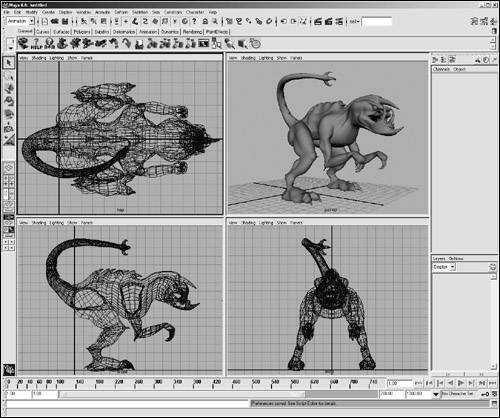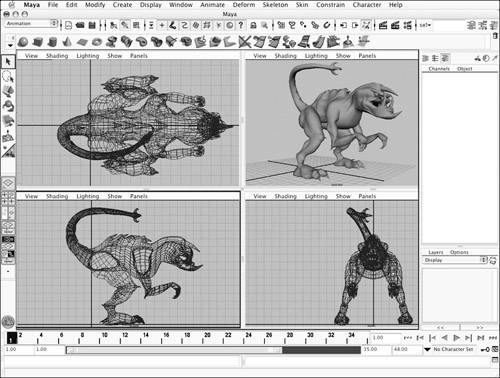Maya Versions and Flavors
|
| This book covers Maya 6 for Windows and Mac OS X (Figures i.2 and i.3). With Maya 6, there's very little difference between the two versionsat least in the features covered here. However, whenever there is a difference in functionality, I'll point it out. Figure i.2. This is the Maya 6 interface as it appears in Windows. Figure i.3. Here's a look at the interface of Maya 6 for Mac OS X. One difference between the Maya interface in the Windows and Mac versions is that the Mac version lets you tear off Hotbox menus. Let's take a closer look at the different flavors of Maya for Windows:
Because this book is for beginning to intermediate users, it covers only those features and tools found in Maya Complete. However, it also covers Fluid Dynamics, which is part of Maya Unlimited, even though it's not available in Maya Complete. What's new in Maya 6?Maya 6 contains hundreds of new features and improvements, many of which were the direct result of customer requests. Notable improvements include a revamped Trax editor, Mental Ray 3.3, new animation abilities, modeling tools, project organization features, workflow enhancements, improved integration with support applications like Adobe Photoshop, and much more. Maya 6 enhances the user's ability to work in real time with a new feature called High Quality rendering, which works in the shaded views. High Quality rendering takes advantage of the latest display card hardware for accelerating OpenGL and provides higher quality real time feedback of what your scene will look like with textures, shadows, and lighting. Maya 6 also now has automatic LOD (Level of Detail) for dense polygonal objects. This means that objects with lots of faces will be drawn with fewer faces so that they are more interactive. These and many other enhancements are covered in this book. For a full list of all the new improvements in Maya 6, go to www.alias.com/eng/products-services/maya/file/maya6_features_in_detail_whitepaper.pdf. |
|